Namespaces in AL - Is it time to start using them?
School’s back, so it’s time for the blogs to get back! This time I want to take a jab at namespaces. Not really the technical “how” of namespaces. I believe that part is rather easy and has already been covered multiple times. Microsoft presented a brilliant session about namespaces at BCTechDays this year. Instead I want to focus on WHY. That’s a question I recently received multiple times. We never needed namespaces in the past, why do we need them now? Do they bring any benefits or are they just a hassle? Is it time to start using them?
Over the past few months, I got to work on apps that were namespaced, apps that weren’t, and completely greenfield apps where I could decide if we wanted to adopt namespaces or not. So, this post is a view on namespaces from my perspective, and feel free to disagree with me.
Why Namespaces?
Structure
I often do “audits” of large code bases for partners, trying to determine the extent of their tech debt, whether they will ever get to multi-app architecture, or reach AppSource compatibility. To be able to do that, I need to understand the app’s architecture, what am I even looking at.
When I have to work with large apps where the src folder looks like this:
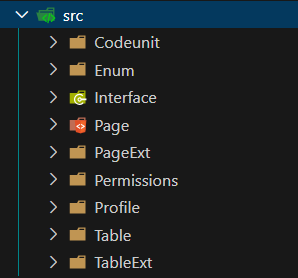
I take a deep breath, ask myself 7 times why am I doing this to myself, and then try to make sense of files that are supposedly important, and work my way through their references. It’s never a fun experience.
On the other hand, if I open a project and the project is separated into areas like this:
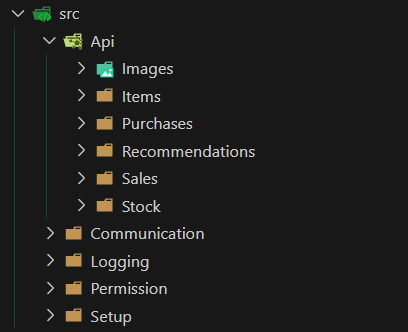
It makes a huge difference. I can wrap my head around individual parts that logically fit together. Structuring your code in functional areas does wonders for discoverability. Shocker, right? Any new developer you try to onboard onto your codebase will have to go through the same process I have to go through, and high discoverability makes this process much smoother. If I can’t convince you that the second folder structure is better than the first one, that I probably won’t ever get you to uptake namespaces…
Fine Tine, organized code is better than not organized, what do namespaces have to do with that?
Well, structuring your code in folders per functional area is in my opinion a prerequisite for starting with namespaces. Discoverability is something legacy codebases lack the most. Not surprising, considering we used to just work with a long list of objects sorted by type and ID.
Let’s say I open a file like this:
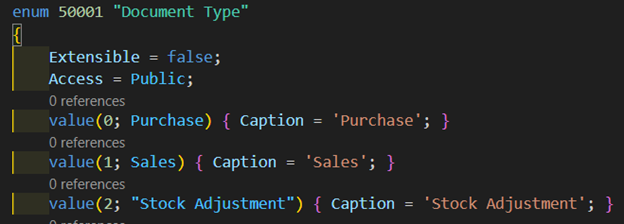
Where does this Enum belong? Who knows… I have to go through the references to figure that out.
But if it has a namespace defined:
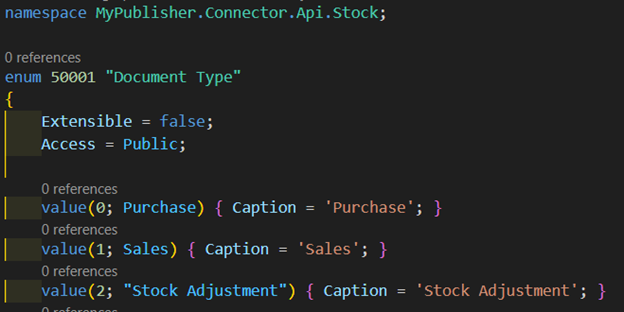
Then I can quickly see it’s part of the Stock APIs functionality. And you’re right, if I only care about the code discoverability, then I could just look at the folder structure where the Document Type file is placed and get the same idea, I don’t need namespaces for that.
But structuring your codebase and making it discoverable is just one of the benefits of namespaces, while it’s the only benefit if you use folders as the only method. That’s why we should do both. Organize code in folders and use namespaces. It makes the project easily discoverable, but also unlocks other benefits of namespaces like dependency analysis.
Dependency Analysis
Let’s talk about dependency analysis next. This one has been huge for me lately. It allows us to ensure that cleanly architected apps remain clean. It also helped with de-tangling functionalities in monolithic apps and breaking down those horrible “Management” codeunits.
I’ll assume you already know that when we start adopting namespaces we move from a global namespace, where we could define any object as a variable, to a specific namespace, where we can only define objects defined in the same namespace, fully qualify object names, or “import” objects from other namespaces using a “using” statement.
In other words, we used to be able to do this:
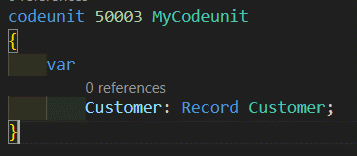
With namespaces, we can’t:

Unless we do one of the two:
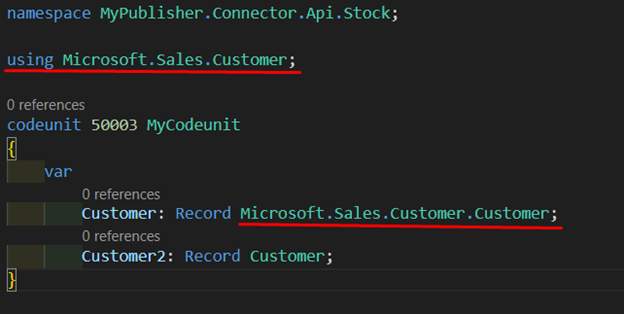
Before we get back to dependency analysis, let’s talk about which of the two options we should go for. Fully qualified name, or the using statement.
We decided to always go with using statements in favor of fully qualified names. Why? Because it allows us to easily see dependencies at the top of the file (this is the dependency analysis that we’ll get to in a second). We haven’t found a real use case when we’d prefer to go for fully qualifying names. In the C# world, I’d go for fully qualified names if I’m using two objects that have the same name but reside in different namespaces. However, in AL:
- We’re quite used to making globally unique object names
- As of now, can’t define an object with the same name in the same app, regardless of namespaces
Back to the dependency analysis now. We now know that anytime we want to define a variable for an object from a different namespace, we have to use a “using” statement. This means that from a quick look, we can see what other modules our object is tied to.
Here’s how a Sales Header table looks once Microsoft applied the namespace to it:
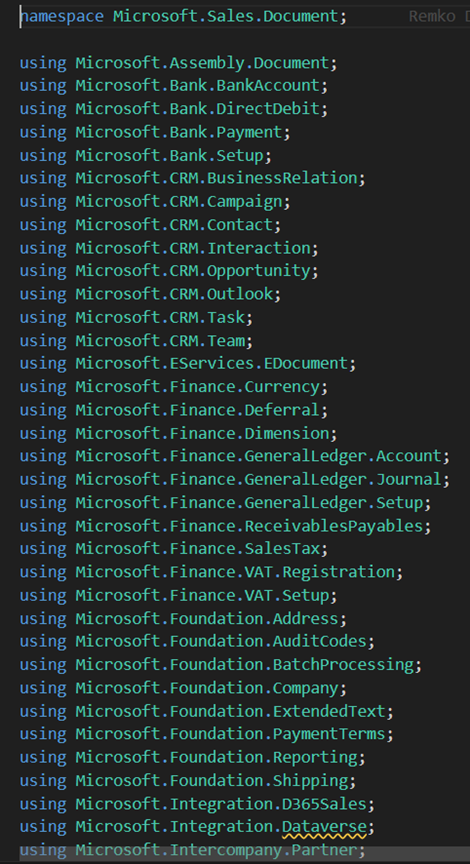
I couldn’t even capture all of them in one screenshot. There are 76 of them. Crazy. Also, a bit ugly. But at the same time a good thing! At least now Microsoft has a high-level overview of all the parts that are jammed in the Sales Header table and can start working towards extracting irrelevant parts.
By irrelevant I don’t mean that the functionality is irrelevant. But does the Sales Header have to be coupled to Dataverse? Or Outlook? Doesn’t it feel a bit off? Removing Dataverse functionality shouldn’t break sales documents. I’m not trying to diss Microsoft’s code. The base app is old, and there’s a lot of legacy code in there. Here’s how the relationships in the Base App look like today:
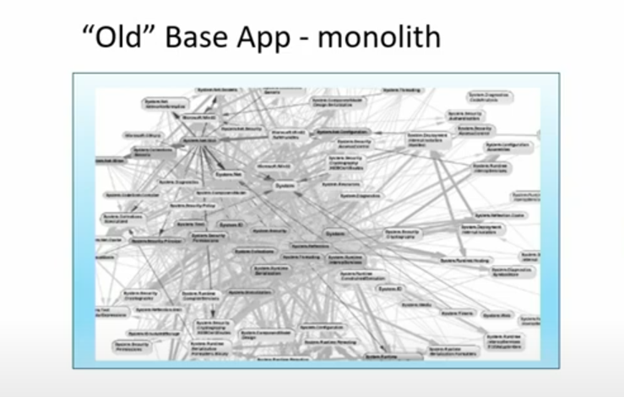
To be honest, we all wrote entangled code like that in the past. But what I’m trying to say is that with namespaces we can now finally start spotting these spider webs. Both in our old code and when writing new code. Does the latest pull request try to add two new “using” statements to a management codeunit? Are we creating another Swiss army knife codeunit? Maybe we should separate them and stick to a single responsibility.
Naming
Naming is a very common reason why we’d want to use namespaces in other languages. As we only ever had a global namespace in AL (and C/AL), all of our objects had to have globally unique names. That’s why we had a “Sales Header” and a “Purchase Header”. If we were in the world of C#, these would likely be Microsoft.Sales.Document.Header and Microsoft.Purchase.Document.Header
Two “Header” objects, but since they reside in separate namespaces, it’s not a naming collision.
Unfortunately, we’re not there yet with AL. Defining two objects with the same name in different namespaces in the same app produces an error.

Which is weird to me, since what I can do is define an object with the same name as an object in a different app. Like creating my own Customer table in my own namespace:

So, namespaces prevent naming collisions, but not in the same app?… Hopefully, this will work in the future…
The one naming benefit we however do have is that we don’t have to try and jam long names in only 30 characters.
Here’s an example from one of the projects: “MYPETaxFSTBlock”
Any idea what this is? Yeah, me neither. ETax and Block I get, but what’s FST?
Well, if we had namespaces at the time, this file would likely be
Namespace MyPublisher.Banking.ETax.Declaration
Codeunit 50000 “MYPFormStructureTypeBlock”
By moving the area that this objects belongs to out of the file name, we free up the 30 characters for actual name of the file. This again makes the codebase more onboarding friendly.
The how of namespaces
I said I won’t go into the “how” of namespaces, but I want to mention a couple more technical good-to-knows about namespaces
How should I structure namespaces?
Here’s what we’re using. Again, only a recommendation and a guideline, deviate from it as much as you’d like.
<Publisher>.<AppArea>.FolderStructure
Example: Companial.Banking.Setup
Important! We don’t (and won’t) register namespaces with MS (like we register affixes), so make sure yours are unique.
- The first part should be your publisher’s name to ensure the namespace is unique from other partners.
- The second part is the App area. Not the App name mind you. We try to find a more generic name. Mainly, so that if we’d ever move an object to a different extension, we don’t end up with an object that has a very app specific namespace and would “stick out”. This point is very applicable to monoliths that we’ll want to break down into smaller apps.
- The third part is then the folder structure. The actual path of the file. This ensures files are easily discoverable by following the namespace.
For comparison, here’s Microsoft’s recommendation:

Whatever you do, please don’t just add one namespace to every object in your project. Unless your project has less than 25 objects, I believe you have multiple areas hiding in there.
How to ensure I don’t forget to add namespaces?
There’s a CodeCop warning (AA0247) we can use to help us spot missing namespaces. It’s disabled by default, so we have to raise it’s severity in the ruleset.json

When should I not adopt namespaces?
If you’re app has a dependency on another app that has not yet adopted namespaces. Do not add namespaces to your objects in these cases as your app will break once the dependency adopts them. Let me quickly show you why:
Here’s the happy path:
App A depends on App B. No namespaces are used. Everything works.

Dependency (App B) introduces a namespace. No issues in App A, as we’re still using the global namespace

App A now introduces namespaces and at the same time has to add a using statement for the dependency codeunit and can compile against the new version of the App B:

Now the unhappy path:
App A is the first to define a namespace and everything works since the Dependency is still in the global namespace:

But now when App B adds a namespace, App A is broken and cannot work with the new version of App B

The problem is, that you don’t know when your dependencies will adopt namespaces, so I’d personally avoid them until all dependencies are namespaces.
In all other cases, I’d say go for it!
Is adding a namespace a breaking change?
No. Yes, we’ve seen how it can break dependencies, but it’s not a breaking change in the sense of the AppSource validation. You can add namespaces to your objects and still pass the validation.
Where can I learn more about namespaces?
The recording of Microsoft’s session is a must-watch if you’d like to see how they approached the challenge of namespacing the whole base app.
Here’s a few common questions they answered in the session:
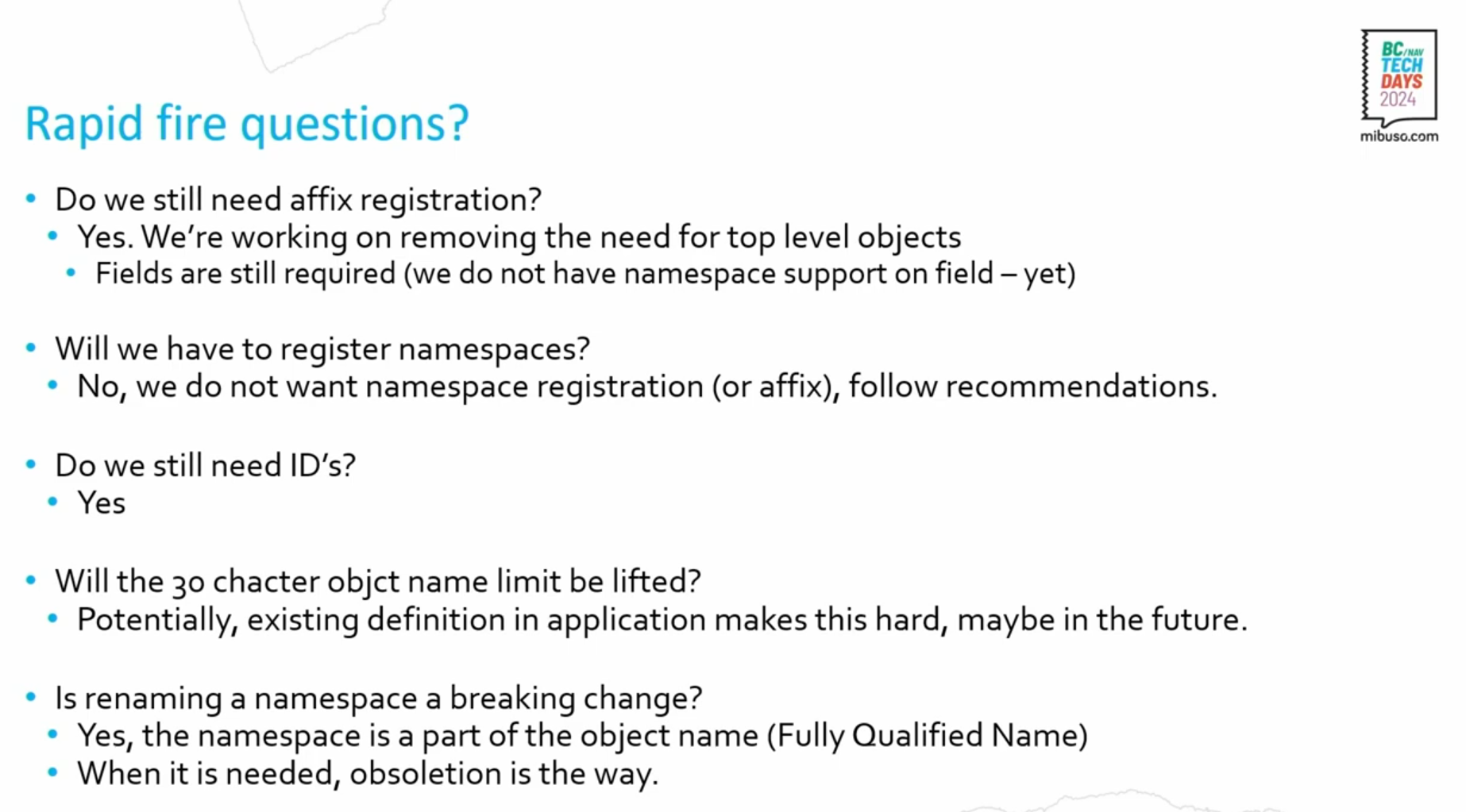
And of course, the official documentation is always a good place to start.
So, is it time to use namespaces and should I now go and namespace my huge monolithic app?
Is it time to use namespaces? Absolutely. Small apps, new apps, greenfield apps, all should start using namespaces. They bring a lot of benefits, and I believe they’re a step towards a cleaner codebase.
But should you go and refactor your huge monolithic app to use namespaces?
Probably not. I mean, yes, there are benefits to using namespaces, but if you have a huge project, it will take you a long time to properly segregate objects into namespaces areas. Unless you have enough time to do it properly, I’d postpone it. Again, adding a single namespace across the whole project is not a good idea.